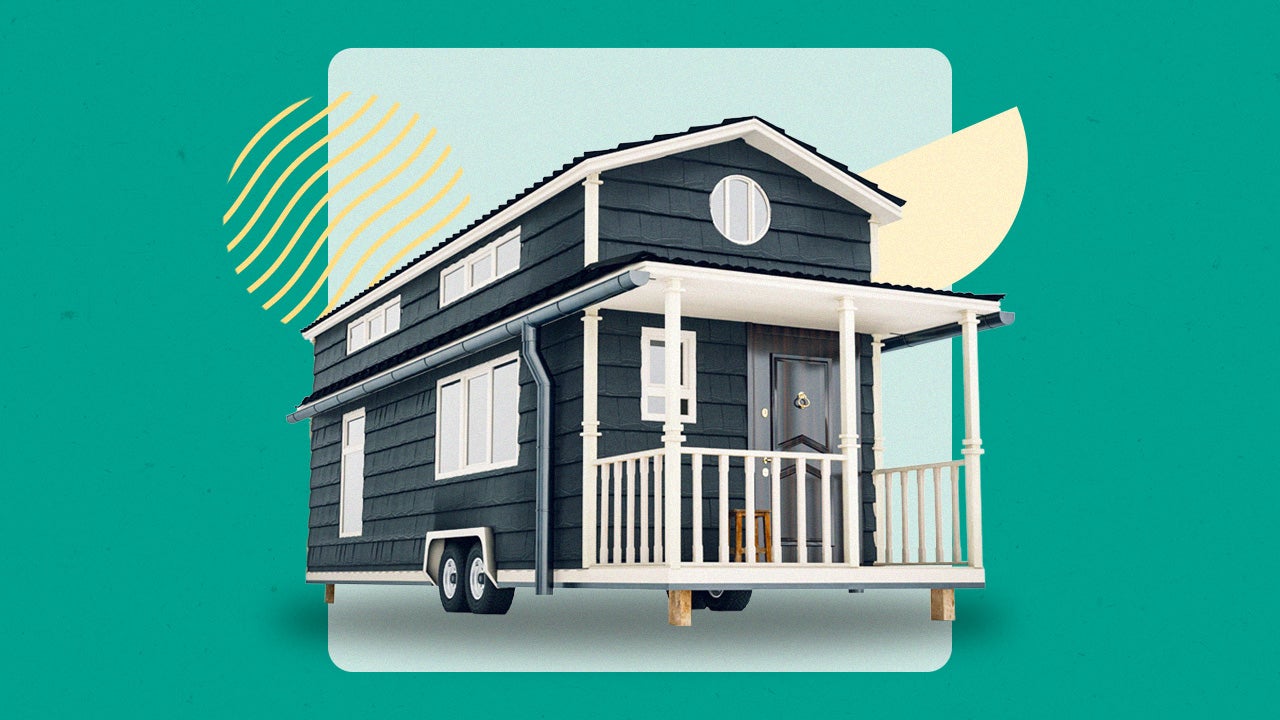Key takeaways
- Tiny houses may qualify for specialty insurance, RV insurance, mobile/manufactured home insurance or be added onto an existing homeowners insurance policy.
- Carriers typically require tiny homes to meet state and local building and zoning codes to qualify for an insurance policy.
- Big-name carriers like Farmers and Progressive have tiny house insurance options.
The modern-day concept of ‘tiny living’ has existed for over 20 years. During times of economic downturn coupled with a lack of affordable housing, simplifying life and buying a home under 400 square feet could be the perfect budget-conscious solution. If you are considering going tiny as a way to safeguard your financial future, be aware that owning a tiny home is different from a standard home and comes with complications ranging from where you can build to what kind of insurance policy the home qualifies for.
Is it possible to insure a tiny home?
Yes, but the kind of tiny home you have dictates the type of insurance you can purchase. DIY builds usually do not qualify for a typical homeowners insurance policy. However, tiny homes that pass inspection from certified builders are more likely to qualify for RV or mobile home insurance with several carriers. Additionally, homes that meet the standards of an accessory dwelling unit (ADU) can be covered under the other structures portion of a homeowners policy.
Should all tiny house owners buy home insurance?
Insurance is a way to protect yourself from financial hardship if you experience a loss to your home or personal property. However, those who follow the true spirit of the tiny home movement may have little to insure. We asked Jay Shafer, author of “The Small House Book” and the person credited as being the founder of the Tiny House Movement, if he insured his current tiny home.
“I’ve never insured any of my tiny houses that I’ve lived in,” Shafer said. “I figured having built this one for about $5,000, the insurance [would] cost more than rebuilding the house itself.”
Shafer tends to keep it simple, owning just a laptop, cell phone, books and clothes. In terms of insurance for personal property and the risks from extreme weather, Shafer said, “I get very concerned about fires when there’s a fire racing in my direction, as they sometimes do in my neck of the woods. But ideally, I would just haul my house on out of there before the fires arrive. I do worry about tree branches falling in high winds sometimes.”
Tiny house living actually does provide a sense of freedom because you aren’t tied to a mortgage payment or rental payment if you own it. And you don’t have to worry about the maintenance cost in the same way as you would for a large home.
— Jay ShaferAuthor of ‘The Small House Book’
Not all tiny house owners will live a life that financially-free. Even if you own your home outright, the average cost of a tiny home is between $20,000 to $50,000 for a simple model, although it can be less if you source the materials and build it yourself. Once you add up the replacement cost of your personal property and factor in liability concerns, getting quotes for home insurance to protect your investment may be a good choice for most homeowners.
What are the insurance requirements for tiny homes?
Some tiny homes don’t require any insurance, while others will. Most banking institutions will require insurance to protect their financial interest if a mortgage or loan is needed for the build. If your tiny house is on wheels, you may need to register your home with the DMV and acquire RV insurance. The requirements depend heavily on state and local laws. Contacting an insurance agent experienced in insuring tiny homes may be a good place to start your search.
What qualifies as a tiny home?
The term “tiny home” has been used as a blanket reference for homes that are small, which can lead to a lot of confusion when it comes time to purchase insurance. According to Shafer, his definition of a tiny house is “any house in which all the space is actually used by the occupants and nothing is missing.” With the popularity of tiny homes creating confusion among insurance carriers and state and local officials regarding zoning, insurability and code regulations, a more rigid definition was created.
A tiny home is between 100 to 400 square feet and falls into two categories: tiny home on wheels (THOW) and tiny homes built on a foundation (THOF). Traditionally, tiny homes are DIY builds, but now, over 150 builders and manufacturers specialize in tiny house production.
These pint-sized homes come in various shapes, sizes and levels of luxury. Some of the most budget- and eco-friendly homes are around 225 square feet and are composed of reclaimed materials. These homes may have composting toilets and use filtered rainwater as the primary source of running water.
On the other end of the spectrum are deluxe tiny house builds that can easily cost over $100,000. While most of these homes are still under 500 square feet, they can come with full-sized appliances and hi-tech space optimization features.
How to find insurance for a tiny home
When looking for the best home insurance for your tiny home, you must first understand what kind of insurance your dwelling will qualify for. Sheri Koones, an ADU specialist and author of “ADUs: The Perfect Housing Solution,” says that tiny houses are “basically mobile homes and are generally not code-compliant.” Therefore, finding coverage can be a challenge. ADUs, on the other hand, are commonly referred to as tiny homes due to their sizes, but must meet zoning laws and building codes, and are generally much easier to insure.
ADUs are considered unattached structures similar to barns or detached garages. They are built on the property by the homeowner and are commonly used as in-law suites, guest or pool houses. If you are considering an ADU on your property, contact your insurance agent to learn about your insurer’s guidelines and limitations. Usually, you can increase your other structures coverage on your current home insurance policy to include the rebuilding cost of the ADU.
I believe ADUs will continue to be more and more popular around North America due to the vast shortage in housing, and particularly affordable housing. Statistics also show that having an ADU on the property raises its property value by about 15 percent.
— Sheri KoonesADU specialist and author of ‘ADUs: The Perfect Housing Solution’
What types of insurance are available for tiny houses?
Although they may not have access to traditional coverage, several insurance options are available to the owners of tiny homes. Each state and insurance provider has its own regulations and underwriting criteria, so you may need to contact several carriers to find the right coverage.
Renters insurance may be available for owners more concerned with insuring their personal property than the dwelling. However, many carriers require the tiny home to meet building codes for the personal property to qualify for coverage. Often, tiny homes that do not meet building and zoning codes are uninsurable or need coverage from a specialty insurer. See the table below to understand what insurance product will likely offer coverage for your tiny home style.
| DIY build | Renters insurance or specialty insurance | Dwelling may need to meet state and local building and zoning codes for contents to qualify for coverage |
| THOW | RV Insurance | Usually, the dwelling must pass the Recreational Vehicle Industry Association (RVIA) certification and be registered with the Department of Motor Vehicles |
| THOF | Mobile/manufactured home insurance | Usually, the dwelling must be certified by the National Organization of Alternative Housing (NOAH) |
| ADU | Traditional homeowners policy (other structures coverage) | Must meet state and local building and zoning codes |
| Tiny house conversion (ex: school bus) | RV Insurance | Usually, the dwelling must pass the RVIA certification and be registered with the Department of Motor Vehicles |
| Yurts | Specialty insurance | Dwelling may need to meet state and local building and zoning codes for contents to qualify for coverage |
How much does it cost to insure a tiny home?
When looking for cheap homeowners insurance for your tiny home, remember that the price will depend on various factors such as building materials, location and natural hazards, to name a few. The average cost of a standard homeowners insurance policy for $250,000 in dwelling coverage as of January 2024 is $1,687. While insuring a tiny home could be drastically less, the risk factors associated with fire and theft of a tiny home and its contents could play a significant role in the pricing. Limiting the amount of personal property you want to insure is one way to keep the cost of home insurance down. With the various tiny home builds and accompanying insurance options, there isn’t one all-encompassing average cost of tiny home insurance, just like there isn’t one typical tiny home.
What are some tiny home insurance providers?
Insurance designed specifically for a tiny home can be hard to find. While many companies offer builder’s risk policies for homes under construction, these policies do not stay in effect once the house is completed or being lived in. The key to finding the right tiny home insurance is looking for insurers that advertise specialty insurance; a specialty insurer may be able to tailor a policy to meet your needs.
Strategic Insurance
Bankrate Score: N/A
Strategic Insurance is one of the only companies offering coverage for tiny homes without requiring certification. With coverage available in 48 states, it may be a good option for homeowners looking for more traditional coverage options for personal liability, other structures and contents.
The Hartford
Bankrate Score: 3.8
The Harford offers builder’s risk policies that can offer financial protection against theft and damage to the tools and building materials while your tiny home is under construction. For a THOW, you may be able to acquire an RV policy if your mobile home meets the requirements. Read Bankrate’s review of The Hartford for more information about this company.
Farmers
Bankrate Score: 3.6
Farmers offers various types of specialty insurance, including coverage for seasonal homes and low-value dwellings. If your tiny home is NOAA-certified, a local Farmers agent may be able to help you secure insurance. To learn more about Farmers Insurance, read Bankrate’s Farmers Insurance review.
Progressive
Bankrate Score: 4.0
Progressive offers insurance for factory-constructed THOW and THOF. DIY builds are not eligible for coverage. Progressive may be a good option for owners who do not move their homes frequently and want to bundle their mobile home coverage with their auto policies. For more information about Progressive, read Bankrate’s Progressive insurance review.
Frequently asked questions
-
-
The best home insurance for your tiny home will depend on what type of coverage you need and what your home can qualify for. Tiny homes that pass RVIA or NOAH certification qualify for more insurance options than DIY builds. Beyond insuring the dwelling, you may want coverage for personal property and personal liability. These additional coverage types can increase the cost of home insurance, but can be vital to protect your financial well-being.
-
As with most things in life, there are drawbacks to consider in any decision. Some of the most common tiny home challenges are:
- Finding a permanent location that allows for DIY tiny home builds
- Reducing the amount of personal items to combat storage issues
- Typically depreciating value of tiny homes as opposed to the typically appreciating value of standard homes
- Qualification issues with most types of insurance policies for DIY builds
-
Standard tiny homes are between 100–400 square feet. However, many manufacturers are starting to produce extra large tiny homes with multiple bedrooms and full-sized bathrooms. Bigger tiny homes typically cost more to build and move, which is something to consider when contemplating a tiny home purchase.
-
Read the full article here

















